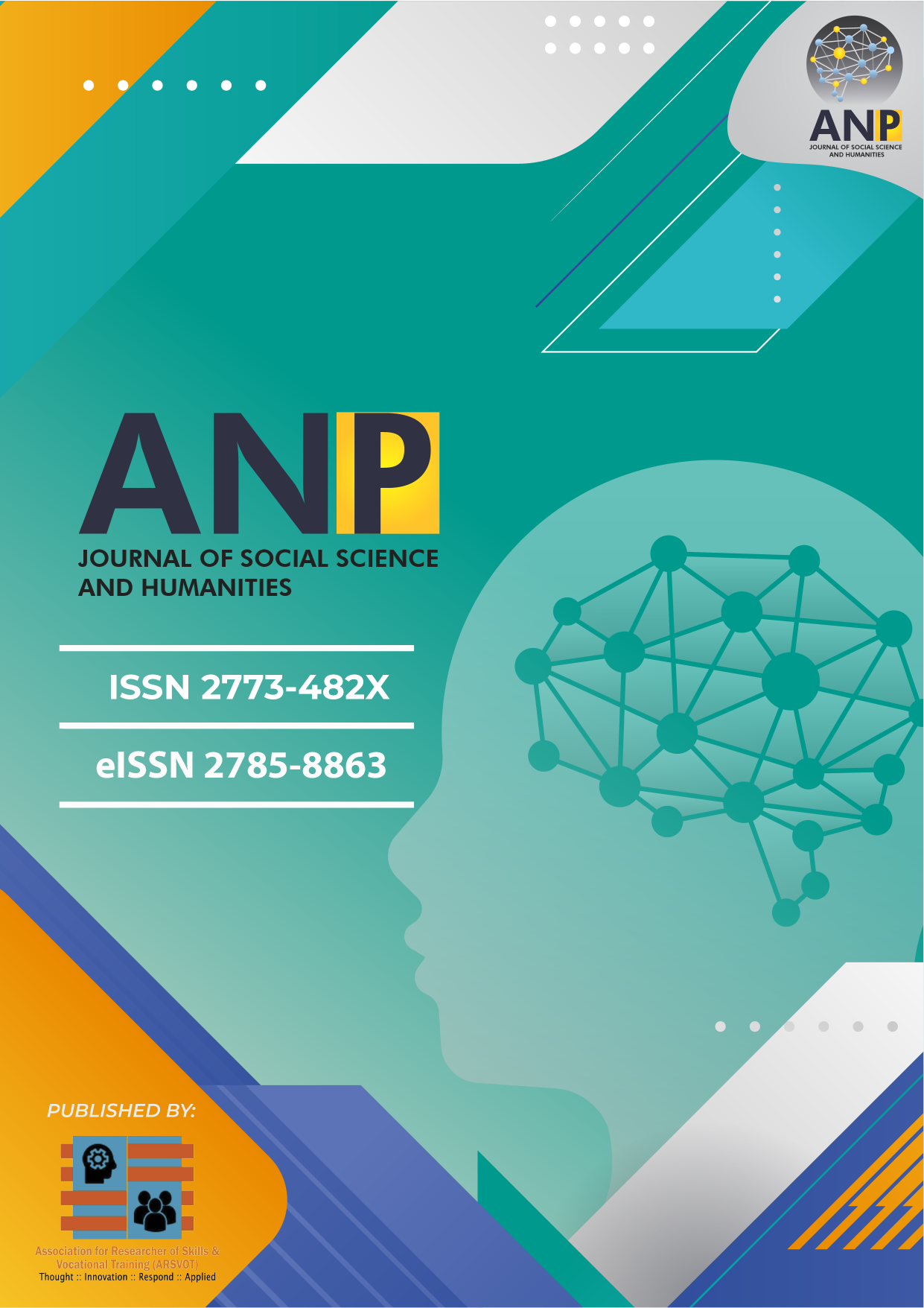Development of 'Boyles Law Apparatus' Teaching Aids for Thermodynamics Course: Innovation in Teaching Methodology
DOI:
https://doi.org/10.53797/anpjssh.v2i1.5.2021Keywords:
Teaching and Learning, Boyle‟s Law‟ Teaching Aids, ThermodynamicsAbstract
Teaching aids are among the most important instruments in providing effective delivery results as well as the best understanding to students. Therefore, this teaching aid should also be in the Thermodynamics course and among the topics whose concept is quite difficult to understand by students is Boyles Law in the topic of Perfect Gas. Boyle's law is used to explain the inverse relationship between pressure and gas volume at a constant temperature. This law states that when the pressure of the container is filled with increasing gas, then the total volume will decrease. Boyles' Law on the topic of Perfect Gas is also one of the important topics and it is the basis in Thermodynamics. This paper is about the development of Boyle's Law Apparatus (BLA) teaching aids (TA) for the DJJ20063 Thermodynamics course at Port Dickson Polytechnic which is an apparatus that can explain to students related to the basic concepts of Boyle's Law. In addition, this teaching aids can also help lecturers in providing a better understanding to students who take Thermodynamics courses. The production of this tool is not only used by lecturers in the theory class but also this tool can also be used for practical needs in the laboratory. In conclusion, a suitable apparatus for explaining Boyle's Law to students has been successfully designed and developed. In this regard, hopefully the innovation of this teaching aids will be able to benefit all parties in improving the teaching and learning system, especially for Thermodynamics course.
Downloads
References
Alam, F., Dilla, E., Subic, A., & Tu, J. (2007). A three - step teaching and learning method in laboratory experiments for a thermal fluid course. World Transactions of Engineering and Technology Education. 6 (1), pp. 13-18.
Alam, F., Tang, H., & Tu, J. (2004). The development of an integrated experimental and computational teaching and learning tool for thermal fluid science, World Transactions on Engineering and Technology Education, 3 (2), pp. 249-252.
Budiyanto, A. (2015), „Pengembangan Alat Peraga Sederhana Struktur dan Organ Dalam Ikan untuk Mempermudah Pembelajaran pada Praktikum Ikhtiologi Perikanan‟, Jurnal Kelautan, vol. 8, no. 2, pp. 83-88.
Chowdhury, H., Alam, F., & Mustary, I. (2019). Development of an innovatiove technique for teaching and learning of laboratory experiments for engineering courses. Energy Procedia, 160(2018), 806–811. https://doi.org/10.1016/j.egypro.2019.02.154
Chowdhury, M. S., & Shahabuddin, A. M. (2007). Self-Efficacy, Motivation and Their Relationship to Academic Performance of Bangladesh College Students. College Quarterly, 10(1), 1-9.
Dukhan, N. (2015). On the worldwide engineering students‟ meager performance in thermodynamics. QScience Proceedings, 2015(4), 17. https://doi.org/10.5339/qproc.2015.wcee2014.17.
Feisel, L. D., & Rosa, A. J. (2005). The Role of the Laboratory in Undergraduate Engineering Education, Journal of Engineering Education, 94, pp. 121-130.
Hasbi, M, A., & Gunawan, K. (2015). „Pengembangan Alat Peraga Listrik Dinamis (APLD) Berbasis Inkuiri untuk Meningkatkan Penguasaan Konsep Siswa‟, Jurnal Penelitian Pendidikan IPA, vol. 1, no. 1, pp. 57-67.
Hashim, A., Yaakub, R., & Ahmad, M. Z. (2003). “Pedagogi: Strategi dan Teknik Mengajar dengan Berkesan.” Pahang: PTS Publications & Distributors Sdn. Bhd.
Indra, M., Darsin, M., & Sumarji. (2011). Sifat Mekanik dan Struktur Mikro Alumunium AA1100 Hasil Pengelasan Friction Stir Welding dengan Fariasi Feed Rate. 15–22.
Kalyani, D., & Rajasekaran, K. (2018). Innovative Teaching and Learning. Journal of Applied and Advanced Research, 3(S1), 23. https://doi.org/10.21839/jaar.2018.v3is1.162.
Le Maréchal, J. F., & Bilani, R. El. (2008). Teaching and learning chemical thermodynamics in school. International Journal of Thermodynamics, 11(2), 91–99. https://doi.org/10.5541/ijot.1034000216.
Makahinda, T. (2019). Application of Performance Assessment and Technology-Applied Approach of Thermodynamics Learning on High School Students. 4(10).
Marisda, D. H. (2014). Pengembangan Modul Fisika Kesehatan Materi Getaran, Gelombang dan Bunyi Melalui Model Pembelajaran Langsung di SMK Kesehatan Terpadu Mega Rezky Makassar. Jurnal Pendidikan Fisika. 4(3): 268-275.
Nasution. (2005). Psikologi Pengajaran Nasional. Bandung: Remaja Rosda Karya.
Preliana, E. (2015). „Pengembangan Alat Peraga Sains Fisika Berbasis Lingkungan untuk Materi Listrik Statis pada Siswa Kelas IX SMP Negeri 3 Pleret‟, JRKPF, vol. 2, no.1, pp. 6-11.
Rashidi & Razak, A. (1996). “Pengajaran dalam Bilik Darjah: Kaedah dan Strategi.”Selangor: Penerbit Masa Enterprise.
Sang, M. S. (2000). “Ilmu Pendidikan Untuk KPLI.” Kuala Lumpur: Kumpulan Budiman Sdn. Bhd.
Saputri, V. A. C., & Dewi, N. R. (2014). „Pengembangan Alat Peraga Sederhana Eye Lens Tema Mata Kelas Viii Untuk Menumbuhkan Keterampilan Peserta Didik‟, Jurnal Pendidikan IPA Indonesia, vol.3, no.2, pp. 109-15.
Yulianti, E., Zulkardi., & Siroj, R, A. (2010), „Pengembangan Alat Peraga Menggunakan Rangkaian Listrik SeriParalel Untuk Mengajarkan Logika Matematika Di Smk Negeri 2 Palembang‟ Jurnal Pendidikan Matematika, vol 4, no.1, pp. 25-32.
Zidny, R., Fadhilah, G. A., Melda, G. E., Sholihah, I. I., Widiastuti, N. L., Haerunnisa, N., & El Islami, R. A. Z. (2019). Simple and Low-Cost Chemical Experiment Kits to Observe the Concept of Gas Laws. Jurnal Penelitian Dan Pembelajaran IPA, 5(1), 16. https://doi.org/10.30870/jppi.v5i1.3917.
Downloads
Published
How to Cite
Issue
Section
License
Copyright (c) 2021 Mohd Fitri Basiran, Suhaila Mohd Sharif, Sharifah Enne Suhaini Syed Mohd Zahari

This work is licensed under a Creative Commons Attribution-NonCommercial-ShareAlike 4.0 International License.




